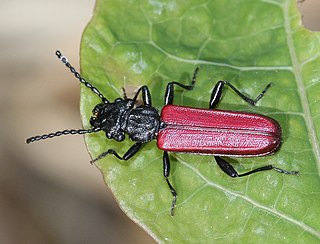
The Cucujidae, or flat bark beetles, are a family of distinctively flat beetles found worldwide under the bark of dead trees. The family has received considerable taxonomic attention in recent years and now consists of 70 species distributed in five genera. It was indicated Cucujus species are scavengers, only feeding on pupae and larvae of other insects and on other subcortical beetles such as their own. Since the Cucujidae prey on larvae of potentially tree damaging beetles that spread fungal diseases, they are considered to be beneficial to the health of living trees.

Myxophaga is the second-smallest suborder of the Coleoptera after Archostemata, consisting of roughly 65 species of small to minute beetles in four families. The members of this suborder are aquatic and semiaquatic, and feed on algae.
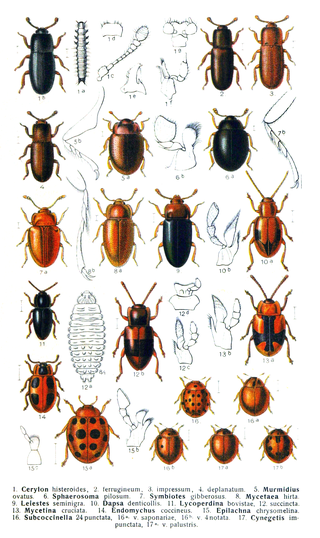
Cucujoidea is a superfamily of beetles. This group formerly included all of the families now included in the superfamily Coccinelloidea. They include some fungus beetles and a diversity of lineages of "bark beetles" unrelated to the "true" bark beetles (Scolytinae), which are weevils.

Prostomidae is a family of beetles with no vernacular common name, though recent authors have coined the name jugular-horned beetles. They are often found in dead wood. The family consist of two extant genera with about 20 species. Prostomis americanus is known from North America. Other species of Prostomis are found in Europe, Africa, the Pacific region and East Asia. Species of Dryocora are known from New Zealand, Australia and Tasmania.

Cucujus is a genus of beetles in the family Cucujidae, the flat bark beetles. It contains 19 currently recognized species and subspecies.

Mecodema is a genus of large flightless ground beetle (Carabidae) endemic to New Zealand. The genus is very diverse in comparison to the other three New Zealand genera within the subtribe Nothobroscina. Mecodema is geographically widespread across both the North and South Islands, as well as numerous offshore islands, including the Three Kings Is., Poor Knights Is., Aotea and Hauturu, Kapiti Is., Stephens Is., Stewart Is., Chatham Is., Snares Is.
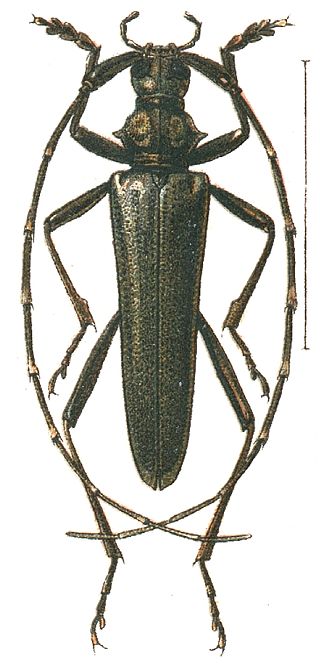
The Disteniidae are a small family of beetles in the superfamily Chrysomeloidea, traditionally treated as a group within the Cerambycidae.

Nosodendridae is a family of beetles, with less than a hundred species in three extant genera, which are found worldwide. Nosodendron, the largest genus, is found in forests and attracted to yeast generated slime on the wounds of trees, and likely consumes fermented substances as well as fungi and microorganisms. Several additional genera and species are known from the fossil record. Nosodendridae is considered to be an isolated lineage within Polyphaga, being the sister group to the clade containing Staphyliniformia, Bostrichoidea and Cucujiformia.

Laemophloeidae, lined flat bark beetles, is a beetle family in the superfamily Cucujoidea characterized by predominantly dorso-ventrally compressed bodies, head and pronotal discs bordered by ridges or grooves, and inverted male genitalia. Size range of adults is 1–5 mm (0.04–0.2 in) in length. Currently, it contains 40 genera and about 450 species, and is represented on all continents except Antarctica; species richness is greatest in the tropics.

Silvanidae, "silvan flat bark beetles", is a family of beetles in the superfamily Cucujoidea, consisting of 68 described genera and about 500 described species. The family is represented on all continents except Antarctica, and is most diverse at both the generic and species levels in the Old World tropics.

Holcaspis is a genus of beetles in the family Carabidae, endemic to New Zealand.

Deinophloeus is a small genus of beetles in the family Laemophloeidae, limited to the New World, where five species are known to occur from Arizona south to Panama. Members of the genus are relatively large for the family, ranging from about 2.5mm to over 4mm in length. Members of the genus are characterized by the absence of a frontoclypeal suture, closed procoxal cavities and, in the male, elongate mandibles, clypeal horns, and modified elytral apices. The immature stages are unknown, and nothing is known about their habits or habitats.

Dysmerus is a genus of beetles in the family Laemophloeidae. Restricted to the New World, until recently Dysmerus included only the type species, D. basalis, described from Florida in the late 19th century. A recent revision resurrected two incorrectly synonymized species and recognized an additional 12 new species, so that the genus currently contains 15 species.
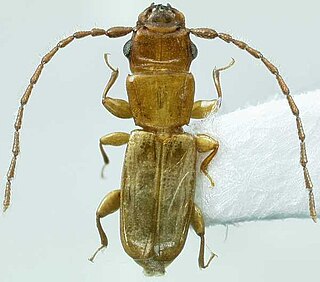
Placonotus is a genus of beetles in the family Laemophloeidae. There are 40 currently recognized species, known from all continents except Antarctica. Placonotus species are small (~2mm), elongate, flattened beetles, characterized by long filiform antennae, presence of a frontoclypeal suture, open anterior coxal cavities, and broadly rounded intercoxal process of abdominal ventrite III. Males have the 8th abdominal segment modified to form claspers used during mating. Adults and larvae are found under dead bark, where they feed on fungi. Currently recognized species are:

Passandridae, the "parasitic flat bark beetles," are a family of beetles notable for being one of the very few beetle families with larvae that are, as far as known, exclusively ectoparasitic on the immature stages of other beetles and Hymenoptera.

Pediacus is the largest genus in the family Cucujidae of flat bark beetles. It contains 31 currently recognized species. Pediacus adults are relatively small (2.7-7.0mm), flattened brownish beetles with no or very small temples, and short antennae with a distinct club. Male genitalia are inverted and possess a short flagellum.

Geodorcus alsobius, or Moehau stag beetle, is a large flightless species of stag beetle in the family Lucanidae. It is found only on Mt Moehau, the highest mountain in the Moehau Range on the Coromandel Peninsula in New Zealand.

Geodorcus auriculatus is a large flightless stag beetle that is found in the southern part of the Coromandel Peninsula and on Mount Te Aroha in the Kaimai range of New Zealand.
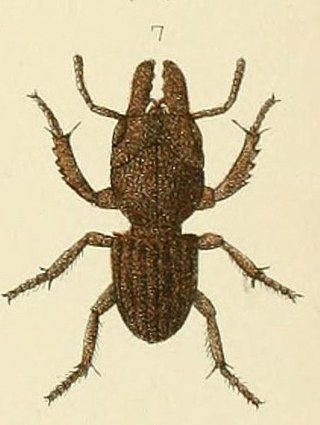
Geodorcus novaezealandiae is a large flightless species of stag beetle in the family Lucanidae. It is the type species and smallest member of the genus Geodorcus. It is endemic to New Zealand.

Geodorcus sororum is a large flightless species of stag beetle in the family Lucanidae. It was discovered in 1973 by Mr. A. Wright on an expedition to Middle Sister Island/Te Awanui, one of The Sisters Islands/Rangitatahi which are part of the Chatham Islands in New Zealand. This holotype specimen is held in the New Zealand Arthropod Collection. It was first described by Beverley Holloway in 2007. The name sororum is translated from Latin to mean "belonging to the sisters".



















